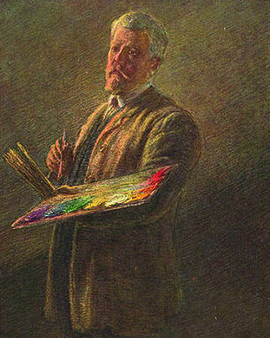The hash smokers are women and they do not smoke a water pipe. The painter Gaetano Previati stages hashish smoking not only as an oriental custom, but rather as a modern, Europeanized custom.
Four women, sitting on the floor, lean their heads back, their hair hidden in headscarves. They are holding home-rolled cigarettes in their hands and, in a room lined with no more than one bed and heavy, brocade-trimmed ceilings, in front of barren, plastered walls, they direct their gaze towards the sky above them behind closed eyes. A sky that the painter deliberately excludes for the viewer. The painting "The Hashish Smokers" was painted in 1887 and reflects the feeling of European decadence. A time whose thoughts, spirit and world-weariness were determined by the writings of Friedrich Nietzsche and the Poetics of the Flowers of Evil by Charles Baudelaire.
Gaetano Previati (1852-1920) felt himself to belong to the Divisionist school. In 1909 he wrote the manifesto "I principi scientifici del Divisionismo" for this group of artists. Like the pointillist Georges Seurat, the other Divisionists were of the opinion that the colour effect to be achieved in the eye of the beholder could not be achieved in advance by physically mixing the colour pigments, but was only produced by the perception of the painting as a whole. This is why the Divisionists separated their colours meticulously and believed that by asking viewers to combine colours themselves optically, they could produce the maximum possible luminosity in their works. The Hashish Smoker was exhibited in Venice in 1887. Many other works by Gaetano Previati show Christian or mythological motifs. The choice of subjects led to Previati's being assigned to the school of the Symbolists.
On the occasion of the 7th Biennale in 1907, Previati was involved in the creation of a "dream room". In Paris he was represented by the art dealer Alberto Grubicy. It was Alberto and his brother Vittore who founded the Società per l'Arte di Gaetano Previati in 1911, bought a large number of his paintings and showed them at exhibitions in Genoa (1915) and Milan (1916 and 1919). Deeply saddened by the loss of his family members, Previati died in 1920 in the town of Lavagna in Liguria, where he had previously spent long periods of recuperation. In 2020, on the occasion of the 100th anniversary of his death, a retrospective exhibition was dedicated to the artist, who was born in Ferrara, focusing in particular on his previously underestimated importance as an Italian futurist. Previati's works as an illustrator of narratives by Edgar Allan Poe and Alessandro Manzoni are the subject of this exhibition. Art historical research shows that, with the cycle of the trade routes, on which the artist worked at the end of his life between 1914 and 1916 for the Milan Chamber of Commerce, Previati now turned in large panels to the defining themes of emerging modernism: "The Pacific Railway" is an example of the enormous versatility of this outstanding Italian artist, whose works range from visionary historical and literary interpretations to phantasmagorical illustrations, paintings of radiant landscapes and touching depictions of icons.
×





.jpg)
.jpg)
.jpg)
.jpg)
_-_(MeisterDrucke-1119966).jpg)
_-_(MeisterDrucke-1119966).jpg)
.jpg)
.jpg)
.jpg)
.jpg)
.jpg)
.jpg)
.jpg)
.jpg)
.jpg)
.jpg)
_Detail_of_right_side_-_(MeisterDrucke-1112603).jpg)
_Detail_of_right_side_-_(MeisterDrucke-1112603).jpg)
.jpg)
.jpg)
.jpg)
.jpg)
_(oil_on_canvas)_-_(MeisterDrucke-1405542).jpg)
_(oil_on_canvas)_-_(MeisterDrucke-1405542).jpg)
.jpg)
.jpg)
.jpg)
.jpg)
_-_(MeisterDrucke-379205).jpg)
_-_(MeisterDrucke-379205).jpg)
.jpg)
.jpg)
_-_(MeisterDrucke-1112439).jpg)
_-_(MeisterDrucke-1112439).jpg)
_-_(MeisterDrucke-697251).jpg)
_-_(MeisterDrucke-697251).jpg)
.jpg)
.jpg)
.jpg)
.jpg)
.jpg)
.jpg)
.jpg)
.jpg)
.jpg)
.jpg)
.jpg)
.jpg)
_final_scene_of_act_IV_of_homon_-_(MeisterDrucke-1423312).jpg)
_final_scene_of_act_IV_of_homon_-_(MeisterDrucke-1423312).jpg)
_-_(MeisterDrucke-1112422).jpg)
_-_(MeisterDrucke-1112422).jpg)
_-_(MeisterDrucke-1411961).jpg)
_-_(MeisterDrucke-1411961).jpg)
_-_(MeisterDrucke-697163).jpg)
_-_(MeisterDrucke-697163).jpg)
.jpg)
.jpg)
.jpg)
.jpg)
_-_(MeisterDrucke-697234).jpg)
_-_(MeisterDrucke-697234).jpg)
.jpg)
.jpg)
.jpg)
.jpg)
.jpg)
.jpg)
.jpg)
.jpg)
_Detail_of_left_side_-_(MeisterDrucke-1117175).jpg)
_Detail_of_left_side_-_(MeisterDrucke-1117175).jpg)
.jpg)
.jpg)
.jpg)
.jpg)
.jpg)
.jpg)
.jpg)
.jpg)
.jpg)
.jpg)
.jpg)
.jpg)
.jpg)
.jpg)
.jpg)
.jpg)
_-_(MeisterDrucke-1459499).jpg)
_-_(MeisterDrucke-1459499).jpg)
.jpg)
.jpg)
_-_(MeisterDrucke-1123377).jpg)
_-_(MeisterDrucke-1123377).jpg)
.jpg)
.jpg)
_Detail_of_central_part_-_(MeisterDrucke-1117174).jpg)
_Detail_of_central_part_-_(MeisterDrucke-1117174).jpg)
.jpg)
.jpg)
.jpg)
.jpg)
.jpg)
.jpg)
.jpg)
.jpg)
.jpg)
.jpg)
.jpg)
.jpg)
_-_(MeisterDrucke-697214).jpg)
_-_(MeisterDrucke-697214).jpg)
.jpg)
.jpg)
_-_(MeisterDrucke-1499926).jpg)
_-_(MeisterDrucke-1499926).jpg)
.jpg)
.jpg)
.jpg)
.jpg)
.jpg)
.jpg)
.jpg)
.jpg)
.jpg)
.jpg)
.jpg)
.jpg)
.jpg)
.jpg)
_-_(MeisterDrucke-1459781).jpg)
_-_(MeisterDrucke-1459781).jpg)
.jpg)
.jpg)
_oil_on_canvas_-_(MeisterDrucke-1104004).jpg)
_oil_on_canvas_-_(MeisterDrucke-1104004).jpg)
.jpg)
.jpg)
.jpg)
.jpg)
.jpg)
.jpg)
.jpg)
.jpg)
.jpg)
.jpg)
.jpg)
.jpg)
.jpg)
.jpg)
.jpg)
.jpg)
.jpg)
.jpg)
.jpg)
.jpg)
.jpg)
.jpg)
.jpg)
.jpg)
.jpg)
.jpg)
.jpg)
.jpg)
.jpg)
.jpg)
.jpg)
.jpg)
.jpg)
.jpg)
.jpg)
.jpg)
_-_(MeisterDrucke-1507717).jpg)
_-_(MeisterDrucke-1507717).jpg)
_charcoal_on_canvas_-_(MeisterDrucke-1119965).jpg)
_charcoal_on_canvas_-_(MeisterDrucke-1119965).jpg)
.jpg)
.jpg)
.jpg)
.jpg)
.jpg)
.jpg)
.jpg)
.jpg)
.jpg)
.jpg)
.jpg)
.jpg)
.jpg)
.jpg)
.jpg)
.jpg)
.jpg)
.jpg)
.jpg)
.jpg)
.jpg)
.jpg)
.jpg)
.jpg)






